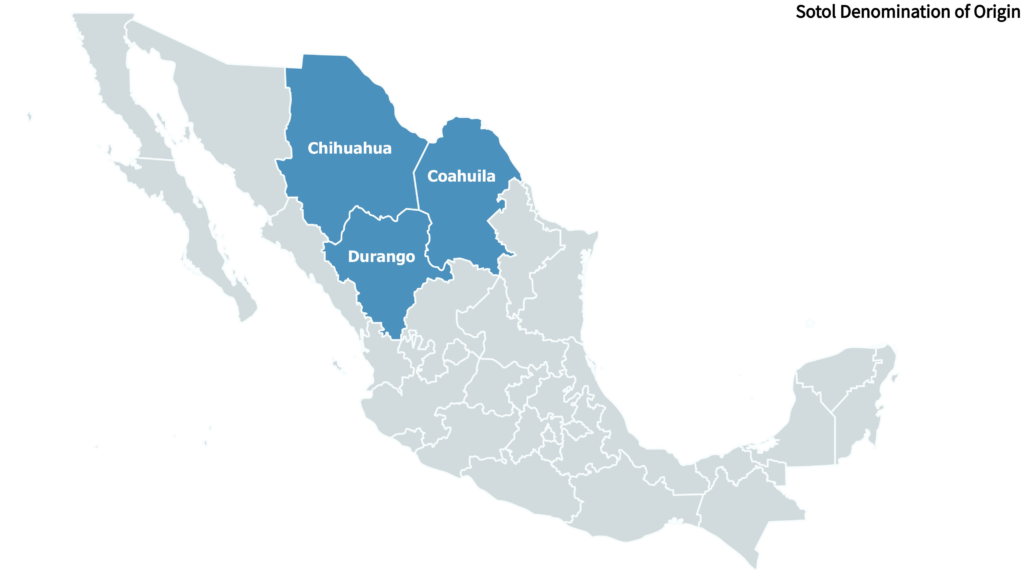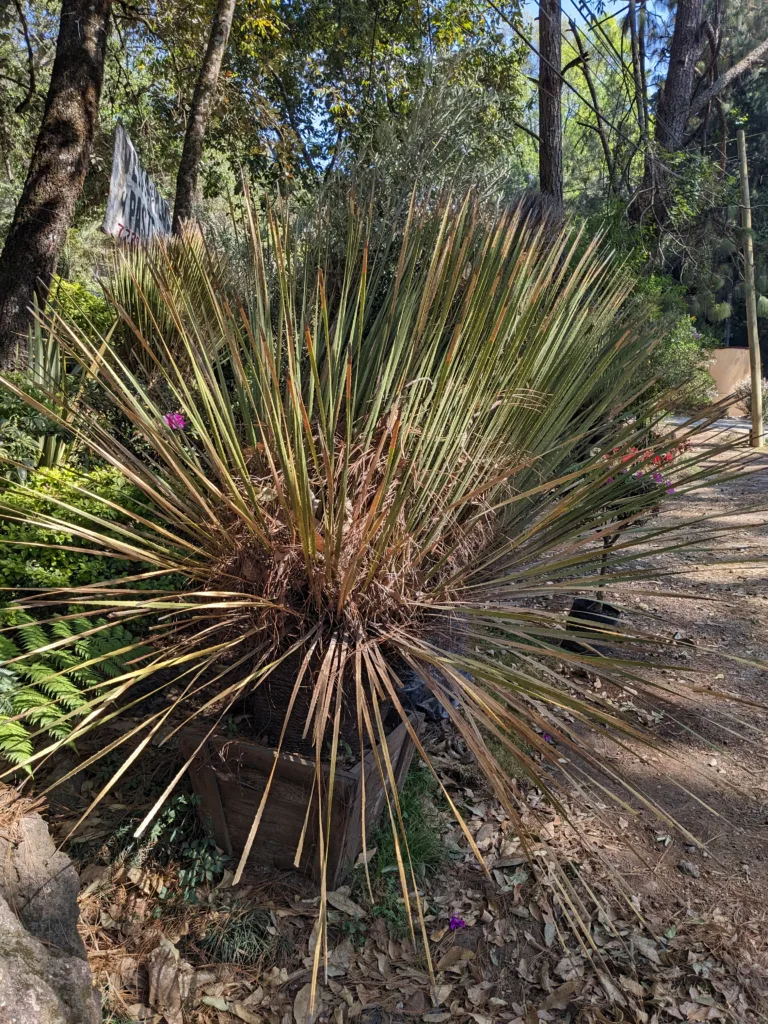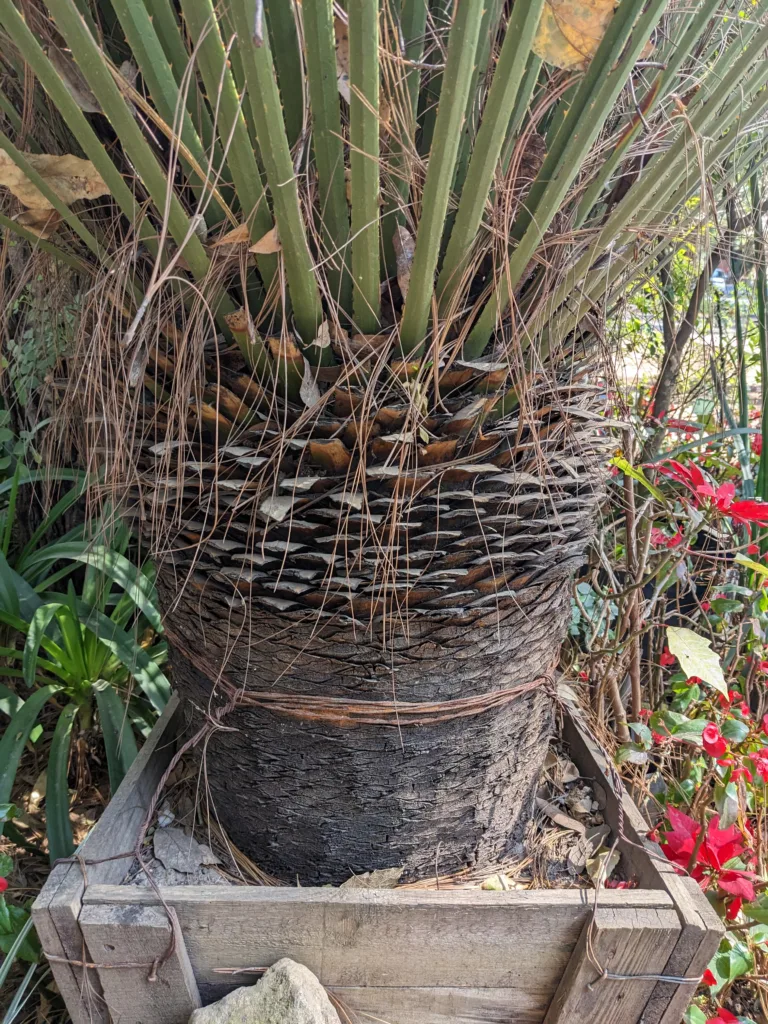Sotol is a distilled spirit made from varieties of the Dasylirion plant in northern Mexico and western Texas. The plant is also known as desert spoon, and sotol or sereque in Spanish. Sotol is made in a very similar manner to mezcal, but because it is not from a species of agave it does not technically qualify as mezcal.
Sotol also has a denomination of origin in Mexico, which are regulations stating where it can be produced, just like tequila and mezcal. These states are Chihuahua (the major producer), Coahuila and Durango. Unlike tequila and mezcal the regulations are not generally recognized outside of Mexico, and there are several producers in Texas for example, selling products labeled as sotol. Sotol production is currently on a much smaller scale compared to tequila and even mezcal. More than 1000 times more tequila is produced than sotol. Mezcal production is about 16 times more than sotol.

Types of sotol
The four main types of sotol are blanco, joven, reposado and añejo. The varieties apart from blanco are aged in oak barrels and tend to take on a golden color. Each of these varieties may contain up to 49% sugars from sources other than the sotol plant, or else be 100% sotol. Pure sotol will be labeled as such, typically with “100% sotol” or “100% puro sotol” or similar.
- Blanco (or silver)
- Bottled after distillation, may have water added to reduce alcohol content
- No additives allowed
- Joven, oro or gold
- A blend of blanco and other aged sotol
- May have undisclosed additives
- Reposado, or aged
- Sotol aged between 2-12 months in oak or other barrels
- May have undisclosed additives
- Añejo, or extra aged
- Sotol aged at least one year in oak or other barrels
What does sotol taste like?
Sotol can be surprisingly complex, with fresh herbal, grassy, earthy and sometimes smokey notes and a long finish – meaning you keep tasting different elements after you swallow. Sotols from different regions and made from different species will have different profiles. Some are more piney, others tend towards more musty flavors. Aged sotols will have more vanilla and caramel elements and while sometimes less complex, are also smoother.
When compared to tequila and mezcal, sotol has more in common with mezcal including its complexity and sometimes its smokiness. The level of smokiness depends on the production method, wood fire baked or steamed. Mezcals are typically wood baked and hence often show more smokey characteristics. Tequila is mostly steamed and so lacks any smokiness. If you are looking to try sotol and you are more a fan of tequila than mezcal, look for bottles made using the steamed cooking process such as those from Hacienda de Chihuahua.
How to drink sotol?
Sotol is best sipped straight at room temperature. Because of its high complexity it is best to drink in a wider mouthed shot glass to enjoy the aromas and nuances. It can also be used in cocktails, particularly as a tequila or mezcal replacement, for example a sotol margarita or paloma. As sotol gains in popularity, many bartenders are creating signature cocktails that match sotol’s unique flavor profile.
Sotol versus Mezcal and Tequila
Plant source
The main difference is that sotol is not made from agave, whereas tequila and mezcal are from agave. The scientific name for sotol plants is Dasylirion. Dasylirion and agave are each a different genus in the same family. The family is called Asparagaceae. Tequila is made just from the blue Weber species of agave and mezcal can be made from any of the hundreds of species of agave.
Currently sotol is exclusively made from wild grown plants. Tequila is essentially all made from farmed agave and while most mezcal is also made from cultivated plants, many brands issue releases from wild grown agave.
Sotol plants can regenerate once harvested unlike agaves.

Denominations of origin
Sotol, tequila and mezcal each have different denominations of origin setting out where they can officially be produced. There is some overlap, but generally Sotol is produced in the north of Mexico, Tequila in the center and mezcal in central and southern Mexico. The denominations of origin, sometimes called appellations of origin, are only internationally recognised for tequila and mezcal.
According to the Mexican regulations sotol can only be produced in Chihuahua, Durango and Coahuila. Tequila can only be produced in the Mexican state of Jalisco, and parts of the states Guanajuato, Michoacán, Nayarit and Tamaulipas. Mezcal can only be produced in Durango, Guerrero, Guanajuato, Michoacán, Oaxaca, Puebla, San Luis Potosi, Tamaulipas and Zacatecas.
Production methods
The tequila, mezcal and sotol industries are all at very different scales of production. For perspective, in 2021 527 million liters of tequila was produced, compared to 8 million liters of mezcal and just half a million liters of sotol.

Tequila production is generally much more industrial than mezcal and sotol, with significantly larger batches produced. The tequila production process is more controlled, mostly using cultivated yeast and steam heated ovens which results in more standardized flavors compared to smaller batch mezcal and sotol. Aging is more common with tequila, whereas sotol and mezcal are more often bottled without spending any time in oak barrels.
The agave piñas used for tequila are most often steamed whereas mezcal is mostly wood roasted, which leaves a smokier flavor. Sotol piñas can be either steamed or roasted, with roasting being the more traditional approach.
Sotol and smaller scale mezcal production often use open air fermentation which means wild yeasts of differing strains can be present with each batch. This increases the diversity and variability of flavor profiles across batches. It is more common to use cultivated yeasts in making tequila, and also larger scale sotol and mezcal production.
Taste
Sotol and mezcal have a much broader range of potential flavors than tequila. The wide range in flavors is due to the variation in species, the smaller scale production, use of wild yeasts and wood roasting techniques commonly employed in mezcal and sotol production. Sotol is typically described as grassy, earthy and sometimes piney although this can vary across species and production methods.
You may find certain sotols taste more like tequila, while others have more in common with mezcal. Tequila is more commonly described as sweet and sometimes peppery or fruity. Any aged spirit, which tequilas often are, will also have more toasty, vanilla notes. Mezcal has a truly wide range of possible flavors, often smokey but can also be sweet, spicy, fruity, herbaceous, creamy or earthy.
Mezcals and sotols are often bottled at a higher alcohol content than tequila. Most tequilas are around the 40% alcohol level whereas it is common for sotols and mezcals to be in the range of 45% to 50% alcohol.
Brands behind sotol
Sotol is still in its relatively early stages commercially, particularly compared to tequila and mezcal. It is more difficult to find at regular liquor stores. Two of the more widely available brands in the United States are Hacienda de Chihuahua and Desert Door. Desert Door is actually produced in Texas. Others include Flor Del Desierto and their sub-brand Onó, Oro de Coyame, Sotomayer and Clande.
Sotol even has its first celebrity brand. Lenny Kravitz is behind the recently launched Nocheluna together with global giant Pernod Ricard and Mexican based Casa Lumbre. Sotol still definitely has a while to catch up to the celebrity tequila boom.
Sotol history
The sotol plant was a food source for the native peoples of North America for thousands of years. The plants grow in the same areas as many species of agave and they share similar characteristics, importantly, a sugar-rich core which can be baked and eaten or stored for eating later.
The name comes from the indigenous Nahuatl word çotolin (or tzotolin) which means “palm”. The long leaves of the plant are also used in weaving many items including baskets, bags and even sandals.
With the Spanish arrival in the late 1500s the process of distillation was introduced. This method was applied first to baked agave and vino de mezcal was born. The word mezcal comes from the indigenous Nahuatl word mexcalli meaning oven baked agave. So vino de mezcal means “wine from oven baked agave”. Given the similarities between agave and the sotol plant, this method was quick to spread and sotol has been produced for hundreds of years.
However, the official classification for sotol with its rules around location and method of production has only been in place since 2002. The rules are known as the Norma Oficial Mexicana (NOM).
Sotol production
Sotol is made from the cooked, fermented and distilled cores of various plant species in the dasylirion genus. The most common species for sotol is dasylirion wheeleri, others include cedrosanum, leiophyllum, and texanum. The sotol plants are almost always wild harvested and can take 10 to 25 years before they reach maturity. The entire plant is harvested but only the sap rich core or piña is used. Once harvested, sotol can grow back, unlike agave used for tequila and mezcal.

Fermentation
The piña is first cooked, then chopped up, and then fermented before being distilled. Cooking can take place in below or above ground ovens. The piñas may be wood roasted or steamed. If wood baked, the ovens are usually lined with volcanic or river stones and fueled with wood such as mesquite or oak. The roasting process takes between three to five days. The cooked piñas are then shredded and added to fermentation vats for between three to 10 days depending on the weather. The fermentation may be left to wild yeasts, or cultured yeast can be added to help the process. For sotol which is not 100% pure, cane or brown sugar is added during fermentation.
Distillation
Distilling the fermented liquid concentrates the alcohol volume and leaves behind the solids. This increases the alcohol from around 6 percent post fermentation, to up to 55% or more. Alcohol turns to steam at a lower temperature than water. Because of this, if the fermented mixture is heated below boiling point the vapor that escapes it can then be collected and condensed back into high strength alcohol. There are no rules concerning the distillation method which can be in clay, copper or steel stills. Most sotols are double distilled and sometimes a third is added.
Water is usually added to dilute to around 40% alcohol and it can then be bottled or aged in wooden barrels between two months to three years or more. The aging process imparts color, softens the taste and adds other flavoring elements often resulting in a more balanced and approachable product.
How strong is sotol?
Under the Mexican regulations Sotol must be between 35% and 55% alcohol, or between 70 and 110 proof. However to be sold in the United States, spirits must be at least 40% alcohol, or 80 proof. Most widely available sotols are between 40% and 45% alcohol. Sotol is a similar alcoholic strength to tequila and mezcal.
Nutritional features
As a distilled spirit, sotol contains zero sugars, zero carbohydrates and zero fats. The only calories are from the alcohol. A standard 1.5 ounce shot of sotol at 40 percent alcohol has 97 calories. This is equivalent to 406 kilojoules in a 44 ml shot. A shot of 45 percent alcohol sotol will have 109 calories or 457 kilojoules.
Sotol has lower calories than beer or wine. For instance, a bottle of regular Budweiser has 145 calories and a 150 ml glass of red wine has 125 calories.
Does sotol contain any additives?
Blanco 100% sotol is not allowed to contain any additives. Its only ingredients are sotol and water. Any sotol not labeled as 100% pure, is likely to be produced from up to 49% from other sources such as sugar cane.
Aged sotol (including joven) may contain other additives such as sugar syrup, caramel coloring, oak extract and glycerine. These additives do not have to be disclosed on the label and in practice never are. Even if the label says for example, 100% sotol reposado, there is a chance it contains these additives. The maximum amount of additives that may be added is 1%
In theory, additives are permitted to achieve a smoother, more consistent taste and texture between batches. The tequila regulations also permit the same four additives.
